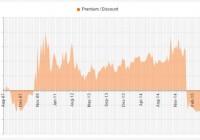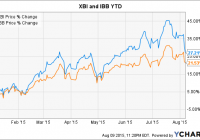SRV: Trading At 20%+ Discount To NAV Due To Supply/Demand Imbalance
Summary Wave of investor outflows has created a significant dislocation. This provides an opportunity for those constructive on the MLP sector to obtain cheap exposure. For others, it also presents some potential to capture alpha through pair trades. Background on Closed-End Funds For those new to the space, a closed-end fund is a publicly traded investment company that raises a fixed amount of capital, and is then structured, listed and traded like a stock on a stock exchange. Whereas conventional mutual funds and ETFs frequently redeem/issue new shares to ensure that the price per share remains in line with the net asset value of the underlying holdings in the funds, this is not the case for CEFs. Rather, the share price of CEFs is driven by the market forces of supply and demand, which sometimes creates attractive opportunities to buy stakes at big discounts to NAV. This tends to happen when sentiment for the particular sector on which a CEF focuses gets decimated, causing some investors to sell irrespective of price. MLPs are one area where we can see this phenomenon most prevalently today. Amidst plummeting commodity prices and rising rate concerns, investor outflows have caused several MLP-focused CEFs to trade at among the widest discounts to NAV in the CEF universe. This presents some opportunities for those that desire cheap exposure to the sector, as well as those that are agnostic on the sector and just want to collect some alpha. Though there are a few examples of other funds worth considering, including Kayne Anderson Energy Development Co (NYSE: KED ) and Cushing Royalty & Income Fund (NYSE: SRF ), in this article, I focus on the Cushing MLP Total Return Fund (NYSE: SRV ) mainly due to the benefits of its large/liquid portfolio and relatively high institutional ownership. As shown below, SRV is currently trading at a ~22% discount to NAV. (click to enlarge) Source: CEF Connect Cushing MLP Total Return Fund Overview SRV is a moderately sized/liquid fund launched in late 2007, which currently has approximately $209 million of total net asset value. The fund’s mandate is to obtain capital appreciation and current income, typically by investing at least 80% of its NAV in MLPs based upon bottom-up fundamental research. The two partners overseeing the fund (bios included here ) each have several decades of experience in the space. The fund’s performance since inception has been poor, at approximately -7% per annum. However, this largely reflects the general downturn in MLPs/commodities over this period as opposed to poor security selection. As shown below, the current portfolio is diversified across a number of MLP subsectors, and is composed of mostly relatively large, liquid names. Annual portfolio turnover is relatively high (~137%), which I view as a marginal negative due to the fact that this can lead to somewhat higher transaction costs. The fund’s annual management fee is moderate at 0.75%, but its total expense ratio (excluding interest and dividends) is higher than average at approximately 2.6% of NAV. Unlike direct holdings in MLPs, SRV does not generate unrelated business taxable income, and Cushing therefore notes that the fund is suitable for IRAs and other tax-exempt accounts. Source: Cushing What will Cause the Discount to Compress? Whenever sentiment in the MLP sector eventually stabilizes and net investor outflows dry up, it is likely that much of SRV’s discount to NAV will naturally dissipate (for the bulk of the fund’s life, it has actually traded at a premium to NAV as can be seen in the first chart above). However, even if simple supply/demand do not naturally compress the discount, there are a couple of other drivers that could. First, SRV has a moderate annual distribution yield of 6.75% (based on current market price). As part of this represents return of capital, the fund partially self-liquidates over time. In addition, the fund has a reasonably concentrated investor base compared to its peers, with institutions holding approximately 24% of shares outstanding. To the extent that a significant discount were to persist over time, these large investors would be incentivized to pressure management to take additional steps to reduce it (e.g., through buybacks or increased distributions). Source: Nasdaq Trade Structuring For investors that want exposure to MLPs, this CEF provides cheap exposure. However, it also presents some potential opportunity to collect alpha for those that are agnostic (or negative) on the space, through pairing a long position in SRV with a short position in an MLP ETF (either through outright equity or options). Though there are several possible shorts to consider, one of the most actionable is the ALPS Alerian MLP ETF (NYSEARCA: AMLP ). This is a large ETF with approximately $8.4 billion of net assets and average daily trading volume of ~$72 million. It is currently relatively easy to borrow, with a rebate rate under -3.5% through some retail brokers, and also has listed options (which can enable investors to avoid dividend costs). The fund seeks to track the Alerian MLP Infrastructure Index, and 7 of its top 10 holdings overlap with SRV’s top 10. Risks/Considerations The obvious risk of this trade is that the timing of discount convergence is unclear, and if investors’ macro fears over commodities/rates grow, there is a possibility that the discount could grow even larger over the near term. The main mitigants are the facts that, as discussed above, the investor base is relatively concentrated with institutional investors, and the fund pays a moderate distribution yield. Short selling, of course, also comes with added risks (e.g., possibility of force buy-ins, increasing borrow costs, etc.) and likely should not be attempted by those new to the market. Disclosure: I/we have no positions in any stocks mentioned, but may initiate a long position in SRV over the next 72 hours. (More…) I wrote this article myself, and it expresses my own opinions. I am not receiving compensation for it (other than from Seeking Alpha). I have no business relationship with any company whose stock is mentioned in this article.

